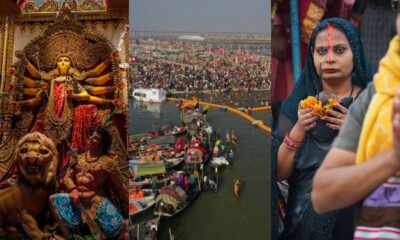Travel Guides & Articles
India Tourism Embraces Eco-Conscious Coastal Development As Andhra Pradesh Leads The Way In New Blue Flag Restoration At Rushikonda Beach Through High-Tech Waste Control And Green Infrastructure

Wednesday, July 16, 2025
India Tourism is taking a significant leap toward sustainable development as Andhra Pradesh intensifies efforts to maintain the Blue Flag certification at Rushikonda Beach by investing in eco-friendly infrastructure, strengthening waste management, and deploying multi-agency coordination to ensure environmental integrity. ThiIndia Tourism Steps Up Environmental Commitment as Andhra Pradesh Revives Blue Flag Status at Rushikonda Beach with Coastal Upgrades and Clean Travel Vision.
As a bold statement to bolster its environmental and tourism image, India Tourism—with the active initiative of Andhra Pradesh—is working diligently to sustain Blue Flag status for Rushikonda Beach at Visakhapatnam. Increased emphasis on sustainability, hygiene, and safety for visitors is a demonstration of a firm commitment on the part of the state towards offering world-class coastal tourism based on eco-friendly practices.
Rushikonda Beach Begins Green Tourism Campaign for India
Rushikonda Beach, a leading seaside spot of Andhra Pradesh, is now a flag-bearer of sustainable tourism for the environment in India. Only those beaches which pass tough tests regarding cleanliness, safety, quality of water, and environmental studies are awarded the Blue Flag certification, a world-renowned eco-label.
With growing footfall from both local and international travelers, state authorities are working tirelessly to preserve the integrity of this certification. Tourism Minister Kandula Durgesh has taken the lead with on-site inspections and has emphasized consistent improvement in waste management, sanitation, and visitor infrastructure.
₹24-Lakh Investment Boosts Beach Infrastructure
To support these sustainability efforts, the Andhra Pradesh government has approved a ₹24 lakh budget allocation for infrastructure enhancements at Rushikonda Beach. This funding is being used to deploy new equipment designed to prevent litter from reaching the ocean—most notably, advanced machines that capture garbage and reduce plastic pollution in marine environments.
Furthermore, a cross-sector coordination task force was instituted to oversee the site’s long-term ecological health. This includes representatives from the Tourism Department, Greater Visakhapatnam Municipal Corporation (GVMC), Andhra Pradesh Pollution Control Board, the National Institute of Oceanography (NIO), and other private stakeholders.
One of the core objectives of this collaborative effort is to locate and eliminate sewage outfalls to ensure that coastal waters remain clean and safe for marine life and tourists alike.
Fighting Disinformation with Data and Rapid Response
To address misleading visuals circulating on social media that misrepresent the current state of the beach, Minister Durgesh has appealed to the public to rely on accurate, updated information shared through verified sources. These outdated images have sparked unnecessary concern and confusion, despite recent improvements on the ground.
In early this year, the beach temporarily lost the Blue Flag status for certain environmental issues. Nevertheless, immediate corrective action, such as upgrading of infrastructure and enhanced monitoring procedures, contributed to the expeditious re-awarding of the title—testifying to the state’s responsiveness and speed.
Vision for Extending Blue Flag Certification Along the Coasts
With the successful reaccreditation of Rushikonda, the Andhra Pradesh government now aims to spread the Blue Flag initiative to other beaches of the state. This bigger picture involves not only environment enhancement, but the creation of new tourism experiences.
Among these are the planned double-decker sightseeing bus launches aimed at supplementing the tourism circuit beyond beaches. These buses will connect tourists to major cultural, historical, and ecological destinations, giving a new layer of depth and diversity to their coastal sojourn.
Leadership Dedicated to Sustainable Development
The programs are the cumulative strategy of the coalition government of reconciling tourism with long-term environmental protection. It means marrying grassroots participation, interagency coordination, and high-tech innovation to create a duplicable model of eco-tourism.
A Greener Horizon for Coastal India
The Rushikonda development is a blueprint for India’s coastal tourism future—where natural beauty is combined with sustainability, and international standards inform grass-roots action. As clean beaches, educated visitors, and environmentalism gain prominence, India Tourism is charting a new course for responsible travel.
Table of Main Developments Summary
| Area of Focus | Description |
|---|---|
| Blue Flag Status | Reinstated at Rushikonda following focused development |
| Infrastructure Funding | ₹24 lakh for pollution control, cleaning, and development of the beach |
| Environmental Task Force | Joint committee comprises GVMC, Pollution Board, NIO, Tourism, and private companies |
| Waste Management | Use of garbage-catching devices to avert sea litter |
| Public Messaging | Countered misinformation with real-time data and government updates |
| Expansion Goals | Plans to apply for Blue Flag status for more beaches |
India Tourism is leading sustainable coastal tourism as Andhra Pradesh ramps up initiatives to maintain Blue Flag status at Rushikonda Beach through cleaner shores, environment-friendly enhancements, and stringent environmental management. This action reiterates the state’s pledge to international tourism standards and sustainable development.
Travel Guides & Articles
The costliest chai in India: How credit cards sell you the lounge dream – Money Insights News

I open Twitter on travel days and see the same posts.
A tray of snacks, a cup of chai, soft chairs in the background, and a caption that says free lounge access with my card. Many people post it and celebrate it. I felt the same when I held multiple cards. Lounge entry felt like a small upgrade, so I told friends to get the same perk.
Then I started reading my statements line by line.
Annual fees after the first year. Spend targets to waive fees. Caps on visits that run out, too. Foreign currency markups on every swipe abroad. Reward values that shift without notice.
That is when I surrendered all my credit cards. I wrote about that decision here: I paid my bills on time and never paid interest. Here is why I quit credit cards anyway.
Since then I look at the lounge photo differently. The chai feels free in the moment, yet the bill often sits elsewhere. It sits in the annual fee. It sits in the spend you do only to keep a waiver. It sits in the forex markup that can exceed the value of the food on your plate. Miss one payment, and the interest can turn that visit into the costliest snack of the year.
This piece is a simple breakdown of that math. Before the next lounge selfie, it helps to ask one question. What did I truly pay for this plate and this chair.
The Annual Fee And The Spend Target
Let us start with the simplest cost. The fee.
When I held multiple cards, the first year felt easy. Free welcome, free visits, free chai. The second year was the turn. Renewal hit. I told myself the lounge perk made it worth it. Then I did the math.
A fee is not a line on a brochure. It is money out of your pocket. If a card costs a few thousand rupees and you visit a lounge three or four times in a year, you have already paid a high price per visit before you even sit down.
Many cards add a condition on top. Spend a large amount in the year and the fee will be waived. That sentence sounds harmless. In real life it changes behaviour.
Think about how people chase that target. I did it too. You bring forward purchases. You choose the card even when UPI or a debit card would have been cleaner. You add an extra order to a sale because the counter is close. You pay a bill early only to push the number up. None of these choices feel wrong in the moment. Together they create spend you would not have done at the same pace. The waiver feels like a win. The extra spend is the real payment.
Caps are the next surprise. Complimentary access is rarely open ended. There are quarterly limits or annual buckets. If your travel is lumpy, you can hit the cap in a single busy month. The next visit is billed. Add-on cards often draw from the same bucket, so a family of four can use up the allowance without noticing. The benefit that looked rich at sign-up becomes thin when you actually need it.
Here is a simple check you should use.
Ask yourself three questions.
- If the card had no lounge access, would I still pay this renewal fee.
- If the only reason I am swiping today is to hit a waiver, would I buy this item otherwise, at this time, at this price.
- If I expect two or three lounge visits in the year, would a direct paid entry on those days cost less than the fee.
Answering honestly is uncomfortable. It was for me. I realised I was paying for a feeling of access rather than a service I used often. That is why I surrendered my cards. If you fly every week, the math can favour a premium card. If you fly a few times a year, the fee and the target can turn a cup of lounge chai into an expensive habit.
In short, the bill for the lounge rarely shows up at the lounge. It hides in renewals, in targets that push spending, and in limits that reduce real use. Once you see that clearly, the next section becomes important. The foreign currency markup that attaches itself to every trip abroad.
The Foreign Currency Markup That Follows You Abroad
Think of a normal trip. You glide into the lounge, click a photo, sip chai, and board. The real bill starts after you land. Every coffee, taxi, museum ticket, and hotel swipe overseas carries a small extra line on your card. That line is the foreign currency markup.
Most Indian credit cards charge about 2 to 3.5 percent on every foreign transaction. Then GST gets added on that fee. The brochure writes it as a neat percentage. On a real trip it feels different.
I noticed this when I still had cards. One family trip. Roughly ₹1,20,000 spent abroad. My statement showed two extra lines I had ignored for years:
- International Markup Fee
- IGST on International Markup
At a 3.5 percent markup, that was ₹4,200. Add 18 percent GST on that fee, about ₹756 more. Total ₹4,956. No one at a counter asked me to pay it. It just appeared on the bill later. That single trip’s markup could have paid for a few lounge entries outright.
Where it adds up
- Every swipe overseas. Cafes, taxis, pharmacies, attractions.
- Online buys in foreign currency. Software, courses, subscriptions, hotel portals that bill in USD or EUR.
- Hotel deposits and car rentals. Pre-authorisations get added and released later. Rate changes in between can create small losses.
- Dynamic currency conversion. The terminal asks, “Pay in INR or pay in local currency.” Choose local currency. INR at the machine often bakes in a poor rate on top of the bank markup.
Run your own “trip test”
- Add up last trip’s foreign spends.
- Multiply by your card’s forex rate.
- Add 18 percent GST on that fee.
- Compare this number with what you actually ate and drank in lounges on that trip.
If the markup plus GST is bigger than your lounge consumption, then the lounge was not free. You paid for it through the markup.
Why this matters for lounge lovers
Many people keep a premium card mainly for international lounge access. The same card then collects 3 percent to 3.5 percent on almost every spend during the trip. If a family spends ₹1,50,000 abroad, a 3.5 percent markup plus GST is roughly ₹6,195. That is real money for a silent line item.
What about zero-forex cards
Some cards advertise zero forex markup. Read the conditions. Often there is a higher annual fee, a cap, or narrow categories. If you travel very often, a clean zero-forex product can work. If you take one or two trips a year, the fee can wipe out the benefit.
Small habits that save a lot
- Always choose to pay in the local currency on the terminal.
- Avoid cash withdrawals on credit cards overseas. Cash advance fees and interest start from day one.
- For online purchases, check the billing currency before you click pay.
- Keep one card for domestic use and one for foreign spends so you can track markups easily.
When I finally laid my statements side by side, the picture was clear. The lounge photo felt free. The markup paid the bill. This was one more reason I surrendered my cards. Next, let us talk about the slow leak that many people miss at home. Rewards that change value and give you less for the same fee.
Before You Renew: A Simple Audit That Works
One note before we wrap. I do not use credit cards now. I surrendered them. Still, I suggest this audit to anyone who cares about value. It is quick, honest, and helps you decide if lounge access is worth it for you.
The five-minute audit
- Count your lounge visits: Last twelve months only.
- Write the annual fee: For each card that promised lounge access.
- Per-visit cost: Fee divided by actual visits.
- Add the forex leak: On your last foreign trip, multiply total overseas spend by your card’s forex rate, then add 18 percent GST on that fee.
- Reality check: Is per-visit cost plus forex leak higher than what you actually ate or drank in lounges. If yes, the lounge is not free.
Small rules that save real money
- Do not chase fee waivers: If you are buying only to hit a target, count that extra spend as a cost.
- Track the cap: Quarterly or yearly limits apply. Add-on cards share the same pool.
- Kill markup at the counter: Always pay in local currency overseas. Avoid cash withdrawals on credit cards.
- Right tool for the job: Keep one simple card for daily use. Use a separate travel card only when you travel.
- Auto-pay in full: One late fee can wipe out a year of perks.
- Downgrade fast: If your fee per visit is high, ask for a waiver or move to a lower-fee product.
- Buy access when needed: If you expect two or three visits a year, paid entry on those days may cost less than a premium fee all year.
Disclaimer
Note: This article relies on data from fund reports, index history, and public disclosures. We have used our own assumptions for analysis and illustrations.
The purpose of this article is to share insights, data points, and thought-provoking perspectives on investing. It is not investment advice. If you wish to act on any investment idea, you are strongly advised to consult a qualified advisor. This article is strictly for educational purposes. The views expressed are personal and do not reflect those of my current or past employers.
Parth Parikh has over a decade of experience in finance and research. He currently heads growth and content strategy at Finsire, where he works on investor education initiatives and products like Loan Against Mutual Funds (LAMF) and financial data solutions for banks and fintechs.
Travel Guides & Articles
IRCTC to lead India’s participation at International Tourism Expo Vietnam 2025 with ASEAN-India Pavilion

NEW DELHI: The Indian Railway Catering and Tourism Corporation (IRCTC), a Government of India enterprise, has been entrusted with the responsibility of organising India’s participation in the prestigious International Tourism Expo (ITE) Vietnam 2025.
This comes after Prime Minister Narendra Modi announced 2025 as the ASEAN-India Year of Tourism, marking a renewed commitment by India to strengthen its cultural, economic, and tourism ties with ASEAN countries.
This expo is being organised from 4 to 6 September this year at the Saigon Exhibition and Convention Centre (SECC) in Ho Chi Minh City, Vietnam.
The Prime Minister’s bold proclamation essentially outlines the pivotal role of tourism in improving people-to-people connectivity, fostering mutual prosperity, and strengthening the bonds of friendship between India and the ASEAN countries.
According to an official source, IRCTC is setting up an exclusive ASEAN-India Pavilion that will showcase a diverse range of tourism offerings from India. These include the country’s rich cultural heritage, spiritual and wellness packages, natural beauty, adventure activities, and premium travel products such as the world-class IRCTC luxury trains: the Maharajas’ Express, the Golden Chariot, and the Buddhist Circuit luxury AC train.
Vipra Pandey, Consulate General of India, inaugurated the ASEAN-India Pavilion in Ho Chi Minh City.
Travel Guides & Articles
Pak-led UN panel refuses to relax Taliban minister's travel ban for India visit: Report | India hasn't recognised Afghan Taliban govt yet | Inshorts – Inshorts
-

 Business1 week ago
Business1 week agoThe Guardian view on Trump and the Fed: independence is no substitute for accountability | Editorial
-
Tools & Platforms4 weeks ago
Building Trust in Military AI Starts with Opening the Black Box – War on the Rocks
-

 Ethics & Policy1 month ago
Ethics & Policy1 month agoSDAIA Supports Saudi Arabia’s Leadership in Shaping Global AI Ethics, Policy, and Research – وكالة الأنباء السعودية
-

 Events & Conferences4 months ago
Events & Conferences4 months agoJourney to 1000 models: Scaling Instagram’s recommendation system
-

 Jobs & Careers2 months ago
Jobs & Careers2 months agoMumbai-based Perplexity Alternative Has 60k+ Users Without Funding
-

 Education2 months ago
Education2 months agoVEX Robotics launches AI-powered classroom robotics system
-

 Podcasts & Talks2 months ago
Podcasts & Talks2 months agoHappy 4th of July! 🎆 Made with Veo 3 in Gemini
-

 Education2 months ago
Education2 months agoMacron says UK and France have duty to tackle illegal migration ‘with humanity, solidarity and firmness’ – UK politics live | Politics
-

 Funding & Business2 months ago
Funding & Business2 months agoKayak and Expedia race to build AI travel agents that turn social posts into itineraries
-

 Podcasts & Talks2 months ago
Podcasts & Talks2 months agoOpenAI 🤝 @teamganassi






















